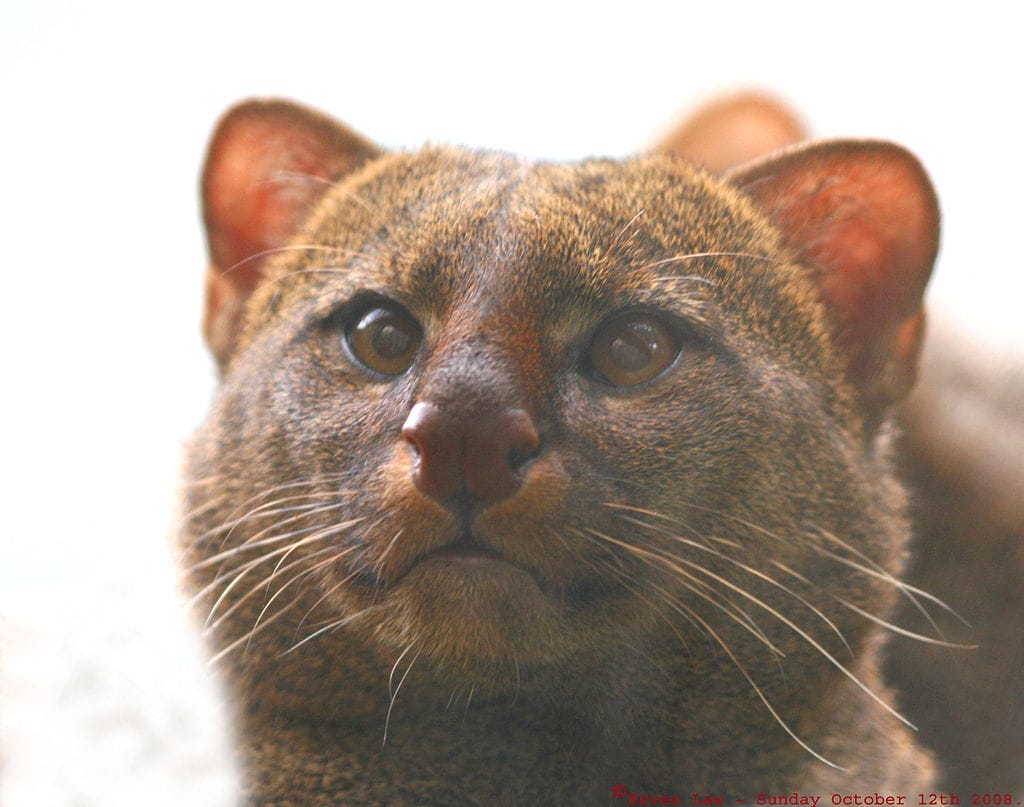Get ready to meet the jaguarundi, a cat like no other! Often called the “otter cat” because of its long, sleek body, this fascinating feline calls home from the mighty mountains of Mexico to the lush rainforests of Argentina. The jaguarundi’s secretive habits and amazing ability to adapt to different environments have made it a mystery to both wildlife lovers and scientists. So, let’s dive into the world of the jaguarundi and uncover its secrets, behaviors, and the challenges it faces today.
The Enigmatic “Otter Cat” of the Americas
Ever heard of a cat that looks more at home in the water than climbing trees? Meet the jaguarundi, a truly unique and fascinating wild cat that calls the Americas home.
Now, don’t let the name fool you – they might be called “jaguarundi,” but they’re not massive like their jaguar cousins. In fact, they’re closer in size to your house cat, weighing in at a svelte 8 to 16 pounds! What sets them apart is their long, slender bodies, short legs, and a tail that reminds you of an otter – hence the nickname “Otter Cat”! This sleek physique helps them navigate their environment with amazing agility and balance.
And speaking of looks, jaguarundis come in two main “flavors,” so to speak: a uniform reddish-brown, almost like cinnamon, or a cool grayish-brown, like a shadow.
A World of Adaptation
These adaptable felines aren’t picky about their addresses! From the lush rainforests of South America all the way up to the scrublands and grasslands bordering the US and Mexico, jaguarundis have made themselves at home in a variety of habitats. They’re like the ultimate survivors!
Jaguarundis are most active during the day, using their incredible senses to stalk prey like rodents, rabbits, and the occasional small reptile. They’ve even been known to snatch a fish or two! While their secretive nature makes them difficult to study, scientists believe that jaguarundis are solitary creatures, except during mating season.
Whispers in the Wild: Jaguarundi Communication
Jaguarundis are the strong, silent type of the cat world. They’re not big on roaring or yowling. Instead, they prefer a more stealthy approach to life. You’re more likely to hear a soft meow, a quick whistle, or a little chirp – just their way of keeping in touch with each other or marking their territory.
The Uncertain Future of the “Otter Cat”
While jaguarundis are currently considered a species of “Least Concern” by conservationists – meaning they’re not in immediate danger of extinction – their populations are, unfortunately, declining in some areas. Habitat loss due to deforestation and human encroachment is a big problem, as is the risk of getting caught in traps set for other animals.
But there’s hope! Scientists and conservationists are working hard to protect the habitats where jaguarundis live and educate people about the importance of coexisting with these amazing creatures. By learning more about them and supporting conservation efforts, we can help ensure that the “Otter Cat” continues to thrive in the Americas for generations to come!
Jaguarundi vs. Jaguar: A Tale of Two Cats
We’ve already established that jaguarundis and jaguars are kin, both belonging to the impressive family of wild cats found across the Americas. But don’t let that fool you, these two are as different as night and day.
Imagine this: the jaguarundi, sleek and otter-like, slinking through the undergrowth, while the powerfully-built jaguar, adorned with its iconic rosettes, stalks its prey in the twilight. These two cats, though related, embody the incredible diversity within the feline family.
Size and Strength
Let’s talk size. A jaguarundi, at 8 to 16 pounds, is dwarfed by its much larger relative, the jaguar, which can weigh up to a massive 220 pounds! This difference in size plays a big role in their hunting styles. The jaguar, a powerful ambush predator, can take down prey as large as deer. The jaguarundi, relying on stealth and agility, focuses on smaller prey like rodents and reptiles.
A Look Back in Time
Interestingly enough, scientists have discovered a fascinating distinction between these two cats at the chromosomal level. Jaguars have 36 chromosomes, which is consistent with other small wild cats found in South America. Jaguarundis, however, have 38 chromosomes, a characteristic they share with Old World cats like the leopard cat. This curious detail suggests that jaguarundis may have diverged from their American counterparts much earlier in evolutionary history.
Conservation Concerns
When it comes to conservation, jaguarundis are currently listed as a species of “Least Concern” by the IUCN. Their adaptability and a relatively wide distribution have helped them maintain relatively stable populations. Jaguars, unfortunately, aren’t so lucky. They’re currently listed as “Near Threatened” due to habitat loss and fragmentation, which makes their future much more uncertain.
So, while jaguarundis and jaguars might share a family resemblance and a love of the Americas, they are remarkably distinct animals. Their differences in appearance, behavior, and even genetics make them a captivating example of the diversity found within the cat family.
Counting Shadows: How Many Jaguarundis Remain in Mexico?
Mexico is a bit of a haven for jaguarundis. Scientists estimate a density of 20 jaguarundis per 100 square kilometers, significantly higher than in regions like Brazil, where they only find 1 to 5 individuals in the same area. This suggests that Mexico could be a crucial stronghold for the species.
However, getting an accurate count on these elusive creatures is incredibly challenging. Their secretive nature and the lack of comprehensive surveys across their range make it difficult to determine an exact number.
Adding to the mystery, a recent study in Texas, utilizing camera traps across a vast area over 18 years, failed to detect a single jaguarundi. However, on the Mexican side of the study area, researchers recorded 126 jaguarundi detections, highlighting the potential for regional variations in population status.
These findings underscore the need for collaborative research efforts between the US and Mexico to better understand and protect these elusive creatures. By unraveling the mysteries surrounding jaguarundi distribution, abundance, and the impacts of habitat loss, we can work towards ensuring their long-term survival in the wilds of Mexico.
Discover how the fearless honey badger takes down its much larger adversary, the African lion. Also, witness the amazing survival technique of the joro spider, as it uses its silk to parachute from tall trees.

















1 thought on “Unveiling the Secrets of the Jaguarundi: The Otter Cat of the Americas”
Comments are closed.